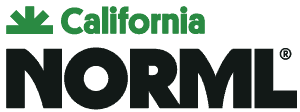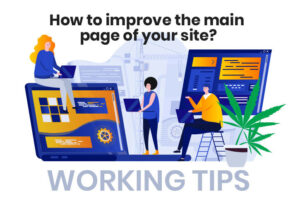Let’s remember: the main page is the “face” of the site, and it should be in order since it is the beginning of the user’s acquaintance with the company. Most often, visitors come here from search engines. Here is the largest percentage of external links, and it distributes the link mass in favor of other pages of the resource.
In SEO optimization of the main page (and other pages), technical factors, semantics, linking, and much more are crucial. But its special role within the cannabis online store makes its adjustments to the optimization process.
What will we talk about:
- Semantics: optimization and updating;
- Content;
- Meta tags: Title, H1, Description;
- Link weight;
- What is bad for homepage optimization?
Semantics: optimization and updating
We recommend starting with collecting the semantic core, namely, the competent distribution of keywords.
In the process of selecting queries, we focus not only on frequency but also analyze the general situation in the search results.
Here we recommend that you pay attention to what queries your competitors are promoting. This will help you build the right strategy or correct an existing one.
You can collect and check keywords using Serpstat or other programs that show how many main pages are promoted for a specified request.
We act according to the following scheme:
- We determine the most common queries describing the activities of the site and collect all possible synonyms;
- We collect the frequency of requests to determine if they can bring us traffic, or it is a “dummy”;
- Check if the different spellings belong to the same group.
Thus, on the homepage, all keywords must be compatible with each other.
For example, we use a tool for uploading the TOP-10. Usually, with its help, we determine whether it is possible to promote requests on one page and then quickly analyze which pages are in the search results (main, categories, or products).
We recommend checking the semantic core every 2-3 months. Is it still valid, or do you need to add/remove/replace keywords?
You can’t do it once and expect that it will work — it’s not the case. The SERP changes quite often, as do the interests of users. If you want to be in the TOP for relevant queries, systematically update the semantic core.
Content
Do you even need text on the homepage? What should the content be like?
Before deciding whether to add text or not, we recommend that you analyze the sites of leading competitors in queries from search results in your topic.
What to pay attention to:
- how much text they have on the main page;
- what keywords do they use for optimization: high-frequency/low-frequency, direct/indirect;
- are there key phrases in the headlines?
- is there any internal linking in the text; if so, where do the links lead to?
After analyzing the competitors, you can start preparing the text, namely, setting the technical specification for the copywriter.
Here, we are guided by the following:
- The H1 heading should reflect the company’s activities and contain an entry for the high-frequency keyword. Whenever possible, they should be catchy;
- After reading the text, the user should learn something new and useful for oneself. We do not recommend making a pitch for yourself on the main page;
- Key queries must be relevant;
- The text must have a structure. A solid canvas of text is just bad manners. An article broken down into paragraphs and blocks, bulleted or numbered lists, tables, etc., looks much better. Probably, the search robot will not notice the difference (although we do not state this), but a visitor will definitely appreciate such a text design. And it is a living person who will buy your product, not a robot.
Instead of specifying a direct keyword, we break it down into individual words that must be mentioned in the text.
What else to look for when optimizing homepage content:
1. Hidden text
At some point, this black SEO trick was best-known among SEO professionals. With the help of a white font, the text with the keywords was hidden under the scroll or off the screen. The user did not see it, but the search robots read the text and highly assessed it. Now you can be banned for this.
By the way, if you bought the site and you are not sure that there is no hidden text, press Ctrl + A. All text, including hidden one, will be highlighted.
2. Page loading speed
In terms of SEO, this parameter is also of great importance — you select the right keywords, optimize the site, etc., the user visits the page, and… leaves without waiting for the site to load. It’s a shame, isn’t it? To prevent this from happening, measure the website loading speed. This can be done, for example, using Google PageSpeed Insights.
In 2018, Google published a study that states that when the download speed increases from 1 to 3 seconds, the probability of rejection increases by 32%. If the loading time increases to 5 seconds, then the possibility of leaving the page will increase by 90%.
If the loading speed of your site leaves much to be desired, we recommend working out the content: compress the photo, upload the video to external resources (Vimeo, for example), and place the link on the main page, etc.
Readme: keep an eye on the quality of your photos and videos. If, for example, images are highly compressed, the quality will be lost, and this may affect traffic.
Speaking of the photo, don’t forget to fill in the alt attributes and short description, including relevant key entries. Also, check that image indexing is not blocked by robots.txt. This will help your resource to take part, among other things, in image search and, in general, to attract additional traffic (crucial for unique content).
Meta tags
These guys help to get additional information about specific pages of the site not only to search engines but also to ordinary users. Well-designed Title, H1, and Description directly affect the CTR (the ratio of the display of a site snippet in organic SERP to clicks on it).
Let’s take a look at each of the meta tags.
Title
It is essential to write down the name of the online store, its specialization, and, in some cases, the region (if it is crucial to pay attention to this).
The capacious description that you write here will be displayed in the search results. Remember this when filling out!
The optimal length is 60-70 characters with spaces.
What we recommend:
- Place a high-frequency unique request here that is relevant to the page. Do not duplicate the keyword from the Title in tags of other pages.
- Write keywords as readable as possible. Similar structure as {cannabis, buy, 24/7, city} is an undesirable format. It is better to write keywords in this way — {Buy cannabis in [city] — prices in the online store [Store name]}.
H1
This tag tells crawlers about the topic of the page and what it says to the visitors. That is why H1 must display the content of the main page as much as possible so that the page is relevant to the search results for the desired queries.
Basic recommendations for filling H1:
- there should be a high-frequency relevant query here;
- the structure of the text should be logical and readable;
- put only one keyword and avoid commercial entries;
- use clean tags without classes, etc. — that is, header tags in the source code.
Description
The importance of this tag cannot be overemphasized. And here’s why: a correctly filled description is displayed by search engines in a snippet and, as a result, users pay more attention to your site.
But this only works if the description is filled in correctly. Otherwise, Google will display the content from the page that is relevant in its opinion.
Recommendations for composing a description:
- The description should not be identical to Title;
- no overspam;
- optimal size — up to 160 characters with spaces;
- you need to take into account the tails from requests from the core. If you do not have the opportunity to specify some words from the core (inexpensive, sizes, prices, etc.) in the Title, it is better to enter them in the Description.
Again, we recommend analyzing competitors, carefully looking at what designs they use. This can be done manually or using an SEO analyzer, for example, SEMrush, AHrefs, etc.
Link weight
The main page, by tradition, collects the largest percentage of internal links and distributes its weight to the rest of the site. At the same time, it has the greatest link weight on the site since every page of the site links to her. That is why it is crucial to choose correctly which links will lead from the main page.
Recommendations:
● Make sure that links to important pages and sections are accessible to search engines
To do this, you can go into the code and check that the links of the main navigation elements are direct links. Also, they must be relative, not absolute — i.e., we write the link without the domain name. For example: <a href=”/catalog/CBD/”> Oils&Capsules </a>;
● Get rid of dangling nodes
These are pages in the main structure to which the link leads, but there is no outgoing link from it. A button for a feedback form, PDF files, etc., can become such a node. In fact, they pull over the incoming link weight and do not bring any benefit.
Getting rid of the dangling node is easy — close the links with a script. This will help to transfer more statistical weight to the priority pages.
● Check the weight of the main page
Again, it is the main page that accumulates the largest number of incoming links, which are further distributed to other pages of the site. If the main one does not have the greatest weight, then a mistake was made somewhere. You can check the main page weight using PageWeight or Netpeak Spider.
By the way, about the number of links. In some materials devoted to SEO optimization of the main page, you can find recommendations for limiting the number of internal links — no more than 100.
In the meantime, there is no specific limit on the number of links in the Google Webmaster Guidelines, just “limit the number of links on a page to a reasonable number (maximum a few thousand).”
In any case, before proceeding with optimization, we recommend analyzing the TOP-10 and seeing how many links the leaders of the niche have.
The same Google constantly says that sites should be for people, with the most useful, high-quality content.
What can harm your homepage SEO optimization?
Of course, we cannot but tell you about the most common mistakes that can destroy all your efforts. In general, they relate to the entire site, but for the main page (in comparison with other pages), they are the most critical.
1. Too much content
In the recommendations, Google writes that “The site should be for people.” So, people don’t read canvases of text. Also, they do not like the awkward interface and crooked keywords, which are clearly out of the question.
By breaking the delicate balance of content and neglecting usability, you run the risk of increasing bounce rates. And this, in turn, entails a decrease in traffic and “negative growth” of the site’s position in search engines.
2. Third-party advertising
Here the principle is the same as in the previous paragraph. A large amount of advertising can scare off even the most loyal fan of your online store. If you are not ready to completely abandon third-party advertising, control its amount.
3. Musical accompaniment
It is definitely a bad idea for an online store. Imagine you are sitting, calmly scrolling through sites and looking for a suitable product, and suddenly, music bursts into your cozy world. It feels pretty strange, don’t you agree? Music will probably be appropriate on image sites, where brand presentation is most important. But when it comes to an online store, we recommend abandoning this idea.
4. Lack of page testing
This includes not only the loading and operation of the page on different devices but also the display of content.
For example, you have placed a photo of a product in the slider on the main page. Above — the name of the special offer. When checked on a standard monitor, everything was okay. But a user who looks at the site on their 4K monitor sees half of the product in the slider, and the text has merged with the photo.
And such errors can be on the entire page: somewhere the text has moved, there is a wrong button, the layout has gone, etc. This, in turn, entails an increase in refusals, and then … Well, you know.
In conclusion
Wow! In this article, we tried to collect the basic information that is important to consider in the SEO optimization of the home page.
At the same time, we remind you: each resource is unique.
Analyze competitors — leaders from search results for relevant queries for your site, take into account the features of your site, apply basic knowledge to the site, and may the growth of traffic and conversions be with you.


